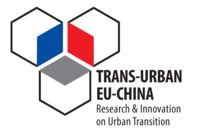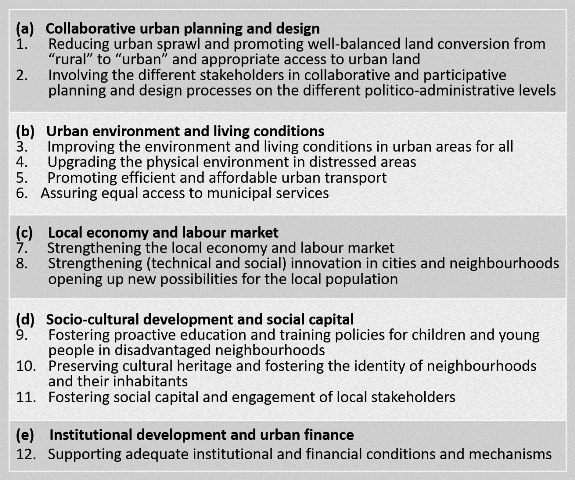
TRANS-URBAN-EU-CHINA
Transition towards urban sustainability through socially integrative cities in the EU and in China
Socially integrative cities1
Definition of the socially integrative city
We define the “socially integrative city” as socially mixed, cohesive, liveable and vibrant. Compactness, functional mix, and intra-urban connectivity as well as equal rights regarding the access to municipal services play an important role. Environmental quality, the quality of public spaces and the quality of life contribute to the well-being of the population. Strengthening a sense of community and fostering a sense of place as well as pre-serving cultural heritage shape the city’s in- and outward-bound image. Investments into neighbourhood improvement, service delivery, infrastructure and the quality of housing are important supportive measures. Empowerment and participation of the population, as well as social capital, are indispensable.
Characteristics of the socially integrative city
Based on the definition of the socially integrative city we see twelve characteristics, which characterise it (see Table). We have grouped them into five dimensions: (a) collaborative urban planning and design, (b) urban environment and living conditions, (c) local economy and labour market, (d) socio-cultural development and social capital, and (e) institutional development and urban finance.
Table: Characteristics of the Socially Integrative City, based on Müller et al. (2019)
(a) | Collaborative urban planning and design |
1. | Reducing urban sprawl and promoting well-balanced land conversion from “rural” to “urban” and appropriate access to urban land |
2. | Involving the different stakeholders in collaborative and participative planning and design processes on the different politico-administrative levels |
(b) | Urban environment and living conditions |
3. | Improving the environment and living conditions in urban areas for all |
4. | Upgrading the physical environment in distressed areas |
5. | Promoting efficient and affordable urban transport |
6. | Assuring equal access to municipal services |
(c) | Local economy and labour market |
7. | Strengthening the local economy and labour market |
8. | Strengthening (technical and social) innovation in cities and neighbourhoods opening up new possibilities for the local population |
(d) | Socio-cultural development and social capital |
9. | Fostering proactive education and training policies for children and young people in disadvantaged neighbourhoods |
10. | Preserving cultural heritage and fostering the identity of neighbourhoods and their inhabitants |
11. | Fostering social capital and engagement of local stakeholders |
(e) | Institutional development and urban finance |
12. | Supporting adequate institutional and financial conditions and mechanisms |
Description of the dimensions
Urban planning and design
Spatial planning and land management for promoting the socially integrative city hold particular potential in countries and cities where urbanisation is happening rapidly. Urban population growth offers the possibility of promoting new spatial forms, new approaches to provision of services, and the creation of new opportunities for urbanizing populations. At the same time, the conversion and further development of older areas offers the possibility to carefully look at the existing structures and deficits, and to design counteractive measures in order to improve living and working conditions. Following the experiences in European countries, urban planning and design can be used to reducing urban sprawl and to promote a well-balanced land conversion from “rural” to “urban” and appropriate access to urban land. The (re-) design of existing neighbourhood can be done in a way, which makes public space attractive for citizens and enhance qualities of the place. Such place-making can also be applied in urban expansion areas. In order to achieve a sustainable growth, regeneration and redevelopment of cities, it is wise to involve all concerned stakeholders, including individual residents and users. Thus, collaborative and participative planning and design on the different politico-administrative levels are decisive instruments to guarantee consent, confidence and well-being.
Urban environment and living conditions
Urban development programmes in Europe and China have proven that interventions to upgrade the physical environment, especially in distressed areas, are an important element to support social integration in cities. Quality public spaces play a special role here. Interventions are supposed to improve the environment and living conditions in urban areas for all. In Europe, interventions in the physical structure of neighbourhoods usually happen in a rather careful way. Methods of “urban acupuncture” and “urban dentistry” are applied in order to protect the urban ensemble while “curing” or renewing only a limited number of areas or buildings. Special attention is given to those areas and buildings which need interventions in order to generate a positive impact on the whole project area. House owners and renters are closely integrated as they are expected to share upgrading efforts on their own. In contrast, approaches in China have more frequently followed a more radical approach, i.e., to completely redevelop an area after relocating and compensating the population living there, while only eventually preserving buildings with historical value. Wherever such developments take place, in inner-urban neighbourhoods or at the edge of cities, it is important to promote efficient and affordable urban transport in order to raise the attractiveness of an area and to promote environmental improvements by reducing emissions. Moreover, renewed and upgraded areas only become attractive and promote social integration if they guarantee equal access to municipal services.
Local economy and labour market
Examples in Europe and China demonstrate that neighbourhoods only become vibrant when there is a strong local economic base. In Europe, the employment situation and especially unemployment have regularly been addressed in programmes. They have proved to be a key element for social integration in cities. Moreover, programmes in Europe and China are often combined with efforts to strengthen the technical and social innovation capacities in cities and neighbourhoods in order to open up new possibilities for the local population. This can be done by attracting new companies to locate in areas which are under transformation, but it can also be achieved through new forms of local services provision, the provision of local markets and small-scale shopping facilities, and local restaurants, as well as joint production models and the economic interchange among the population.
Socio-cultural development and social capital
Social capital is “the glue that holds societies together and without which there can be no economic growth or human well-being”, as Ismail Serageldin, the then World Bank Vice President, wrote at the end of the 1990s. Although a number of scholars used the term since the early 1900s, it only became popular upon Robert Putnam’s seminal publications in the 1990s and especially in 2000. In the context of a neighbourhood or a city, social capital can be described intense interpersonal relations, shared values and trust, a shared sense of identity as well as preparedness to cooperate among the inhabitants. It is almost self-explaining that social capital is a decisive prerequisite of the socially integrative city. Successful programmes in Europe have demonstrated the key role of measures to raise the social capital in neighbourhoods, e.g., through respective neighbourhood or community management approaches. Thus, programmes, which address the socially integrative city, should try to foster social capital and the engagement of stakeholders in an urban area. Moreover, other related socio-cultural issues play an important role. Therefore, the preservation of cultural heritage and other culture-related measures help to raise the sense of identity and belonging of residents. And finally, proactive education and training policies, especially for children and young people, help to raise perspectives of younger generations and a sense for valuing the place they belong to.
Institutional development and urban finance
Any support programmes for promoting the socially integrative city are dependent on adequate institutional settings. These have to be open, supportive and flexible if they shall bring about success: open in the sense to be prepared to take up new ideas and developments; supportive in a way that they are regarded by the population as being useful and encouraging initiatives; and flexible in the sense that they are open for change as transformation processes, especially in distressed areas, are hardly predictable and have higher uncertainties. Moreover, financial conditions and mechanisms should be appropriate to bring about achievements for the population. European experience has shown that projects are especially successful when different stakeholders join hands in their efforts to achieve social integration in neighbourhoods and cities, i.e., governments on the different levels, the private sector and the population. Their shares have to be individually negotiated and decided.
1 This section is based on the contents of the “Workshop Report on theoretical aspects of transition towards urban sustainability and the role of socially integrative cities” (D6.6), published online in March 2019 (http://transurbaneuchina.eu/fileadmin/user_upload/tuec/files/Deliverables/TRANS-URBAN-EU-CHINA_D6.6.pdf) and on Chapter 2 of the book “Towards Socially Integrative Cities”, edited by Müller et al. 2021 within the framework of the TRANS-URBAN-EU-CHINA project (http://transurbaneuchina.eu/fileadmin/user_upload/tuec/files/Deliverables/TRANS-URBAN-EU-CHINA_D6.8.pdf)
